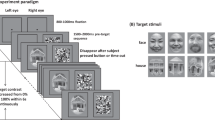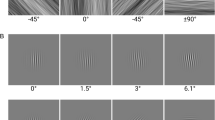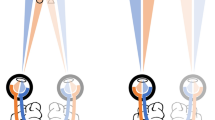Abstract
Illusions that produce perceptual suppression despite constant retinal input are used to manipulate visual consciousness. Here we report on a powerful variant of existing techniques, continuous flash suppression. Distinct images flashed successively at ∼10 Hz into one eye reliably suppress an image presented to the other eye. The duration of perceptual suppression is at least ten times greater than that produced by binocular rivalry. Using this tool we show that the strength of the negative afterimage of an adaptor was reduced by half when it was perceptually suppressed by input from the other eye. The more completely the adaptor was suppressed, the more strongly the afterimage intensity was reduced. Paradoxically, trial-to-trial visibility of the adaptor did not correlate with the degree of reduction. Our results imply that formation of afterimages involves neuronal structures that access input from both eyes but that do not correspond directly to the neuronal correlates of perceptual awareness.
This is a preview of subscription content, access via your institution
Access options
Subscribe to this journal
Receive 12 print issues and online access
$209.00 per year
only $17.42 per issue
Buy this article
- Purchase on Springer Link
- Instant access to full article PDF
Prices may be subject to local taxes which are calculated during checkout





Similar content being viewed by others
References
Koch, C. The Quest for Consciousness: A Neurobiological Approach (Roberts, Greenwood Village, Colorado, 2004).
Blake, R. & Fox, R. Adaptation to invisible gratings and the site of binocular rivalry suppression. Nature 249, 488–490 (1974).
He, S., Cavanagh, P. & Intriligator, J. Attentional resolution and the locus of visual awareness. Nature 383, 334–337 (1996).
Rajimehr, R. Unconscious orientation processing. Neuron 41, 663–673 (2004).
Hofstoetter, C., Koch, C. & Kiper, D.C. Motion-induced blindness does not affect the formation of negative afterimages. Conscious. Cogn. 13, 691–708 (2004).
Macknik, S.L. & Martinez-Conde, S. Dichoptic visual masking reveals that early binocular neurons exhibit weak interocular suppression: implications for binocular vision and visual awareness. J. Cogn. Neurosci. 16, 1049–1059 (2004).
Rees, G., Russell, C., Frith, C.D. & Driver, J. Inattentional blindness versus inattentional amnesia for fixated but ignored words. Science 286, 2504–2507 (1999).
Bonneh, Y.S., Cooperman, A. & Sagi, D. Motion-induced blindness in normal observers. Nature 411, 798–801 (2001).
Logothetis, N.K. & Schall, J.D. Neuronal correlates of subjective visual perception. Science 245, 761–763 (1989).
Leopold, D.A. & Logothetis, N.K. Activity changes in early visual cortex reflect monkeys' percepts during binocular rivalry. Nature 379, 549–553 (1996).
Sheinberg, D.L. & Logothetis, N.K. The role of temporal cortical areas in perceptual organization. Proc. Natl. Acad. Sci. USA 94, 3408–3413 (1997).
Lumer, E.D., Friston, K.J. & Rees, G. Neural correlates of perceptual rivalry in the human brain. Science 280, 1930–1934 (1998).
Tong, F., Nakayama, K., Vaughan, J.T. & Kanwisher, N. Binocular rivalry and visual awareness in human extrastriate cortex. Neuron 21, 753–759 (1998).
Polonsky, A., Blake, R., Braun, J. & Heeger, D.J. Neuronal activity in human primary visual cortex correlates with perception during binocular rivalry. Nat. Neurosci. 3, 1153–1159 (2000).
Pasley, B.N., Mayes, L.C. & Schultz, R.T. Subcortical discrimination of unperceived objects during binocular rivalry. Neuron 42, 163–172 (2004).
Williams, M.A., Morris, A.P., McGlone, F., Abbott, D.F. & Mattingley, J.B. Amygdala responses to fearful and happy facial expressions under conditions of binocular suppression. J. Neurosci. 24, 2898–2904 (2004).
Wolfe, J.M. Reversing ocular dominance and suppression in a single flash. Vision Res. 24, 471–478 (1984).
Kreiman, G., Fried, I. & Koch, C. Single-neuron correlates of subjective vision in the human medial temporal lobe. Proc. Natl. Acad. Sci. USA 99, 8378–8383 (2002).
Wilke, M., Logothetis, N.K. & Leopold, D.A. Generalized flash suppression of salient visual targets. Neuron 39, 1043–1052 (2003).
Lack, L.C. Selective Attention and the Control of Binocular Rivalry 117–169 (Mouton, The Hague, The Netherlands, 1978).
Wiesenfelder, H. & Blake, R. The neural site of binocular rivalry relative to the analysis of motion in the human visual system. J. Neurosci. 10, 3880–3888 (1990).
Blake, R. Psychoanatomical strategies for studying human visual perception. in Early Vision and Beyond (eds. Papathomas, T.V., Chubb, C., Gorea, A., & Kowler, E.) 17–25 (M.I.T. Press, Cambridge, Massachusetts, 1995).
Moradi, F., Koch, C. & Shimojo, S. Face adaptation depends on seeing the face. Neuron 45, 169–175 (2005).
Blake, R. & Logothetis, N.K. Visual competition. Nat. Rev. Neurosci. 3, 13–21 (2002).
Alpern, M. & Barr, L. Durations of the after-images of brief light flashes and the theory of the Broca and Sulzer phenomenon. J. Opt. Soc. Am. 52, 219–221 (1962).
Brindley, G.S. Two new properties of foveal after-images and a photochemical hypothesis to explain them. J. Physiol. (Lond.) 164, 168–179 (1962).
Loomis, J.M. The photopigment bleaching hypothesis of complementary after-images: a psychophysical test. Vision Res. 12, 1587–1594 (1972).
Loomis, J.M. Complementary afterimages and the unequal adapting effects of steady and flickering light. J. Opt. Soc. Am. 68, 411–416 (1978).
Virsu, V. & Laurinen, P. Long-lasting afterimages caused by neural adaptation. Vision Res. 17, 853–860 (1977).
Sakitt, B. Psychophysical correlates of photoreceptor activity. Vision Res. 16, 129–140 (1976).
Wilson, H.R. A neural model of foveal light adaptation and afterimage formation. Vis. Neurosci. 14, 403–423 (1997).
Kelly, D.H. & Martinez-Uriegas, E. Measurements of chromatic and achromatic afterimages. J. Opt. Soc. Am. A 10, 29–37 (1993).
Craik, K.J.W. Origin of visual after-images. Nature 145, 512 (1940).
Shimojo, S., Kamitani, Y. & Nishida, S. Afterimage of perceptually filled-in surface. Science 293, 1677–1680 (2001).
Breese, B.B. On Inhibition. Psychol. Monogr. 3, 1–65 (1899).
Levelt, W.J.M. On Binocular Rivalry (Institute for Perception RVO-TNO, Soesterberg, The Netherlands, 1965).
Fox, R. & Rasche, F. Binocular rivalry and reciprocal inhibition. Percept. Psychophys. 5, 215–217 (1969).
Bossink, C.J., Stalmeier, P.F. & De Weert, C.M. A test of Levelt's second proposition for binocular rivalry. Vision Res. 33, 1413–1419 (1993).
Anstis, S., Rogers, B. & Henry, J. Interactions between simultaneous contrast and coloured afterimages. Vision Res. 18, 899–911 (1978).
Hayhoe, M.M. & Williams, D.R. Disappearance of afterimages at 'impossible' locations in space. Perception 13, 455–459 (1984).
Suzuki, S. & Grabowecky, M. Attention during adaptation weakens negative afterimages. J. Exp. Psychol. Hum. Percept. Perform. 29, 793–807 (2003).
Lou, L. Effects of voluntary attention on structured afterimages. Perception 30, 1439–1448 (2001).
Weiskrantz, L. An unusual case of after-imagery following fixation of an 'imaginary' visual pattern. Q. J. Exp. Psychol. 2, 170–175 (1950).
Sengpiel, F., Blakemore, C. & Harrad, R. Interocular suppression in the primary visual cortex: a possible neural basis of binocular rivalry. Vision Res. 35, 179–195 (1995).
O'Regan, J.K. & Noe, A. A sensorimotor account of vision and visual consciousness. Behav. Brain Sci. 24, 939–73 (2001).
Lamme, V.A. Why visual attention and awareness are different. Trends Cogn. Sci. 7, 12–18 (2003).
Chan, D., Crutch, S.J. & Warrington, E.K. A disorder of colour perception associated with abnormal colour after-images: a defect of the primary visual cortex. J. Neurol. Neurosurg. Psychiatry 71, 515–517 (2001).
Weiskrantz, L. Prime-sight and blindsight. Conscious. Cogn. 11, 568–581 (2002).
Schiller, P.H. & Dolan, R.P. Visual aftereffects and the consequences of visual system lesions on their perception in the rhesus monkey. Vis. Neurosci. 11, 643–665 (1994).
Brainard, D.H. The Psychophysics Toolbox. Spat. Vis. 10, 433–436 (1997).
Acknowledgements
We thank R. Kanai, C. Hofstoetter, D.A. Wu, F. Moradi, R. Van Rullen and S. Shimojo for discussion. This research was funded by grants from the US National Institute of Mental Health, the US National Science Foundation, the Keck Foundation and the Moore Foundation.
Author information
Authors and Affiliations
Corresponding author
Ethics declarations
Competing interests
The authors declare no competing financial interests.
Supplementary information
Rights and permissions
About this article
Cite this article
Tsuchiya, N., Koch, C. Continuous flash suppression reduces negative afterimages. Nat Neurosci 8, 1096–1101 (2005). https://doi.org/10.1038/nn1500
Received:
Accepted:
Published:
Issue Date:
DOI: https://doi.org/10.1038/nn1500
This article is cited by
-
Learned value modulates the access to visual awareness during continuous flash suppression
Scientific Reports (2023)
-
Feature-based interaction between masks and target in continuous flash suppression
Scientific Reports (2023)
-
Effects of invisible lip movements on phonetic perception
Scientific Reports (2023)
-
Spatial perspective and identity in visual awareness of the bodily self-other distinction
Scientific Reports (2023)
-
The limits of unconscious semantic priming
Current Psychology (2023)



